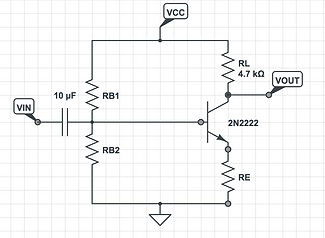Electrical Engineering
Circuit Analysis
-
Resistive circuits, voltage, and current sources, network theorems
-
Op-amp circuits, energy storage elements, RC and RL circuits, and AC steady-state analysis
-
AC power, 3-phase circuits, mutual inductance, series, and parallel resonance and two-port networks, frequency response, and Bode plots
Energy Conversion Electromagnetics
-
Magnetic circuits and electromagnetic devices, theory of operation and operating characteristics of transformers, and AC induction and synchronous machines
-
Single-phase and three-phase transformers, rotating machines
Semiconductor Device Electronics
-
Internal operation, semiconductor physics, terminal characteristics, models and application of diodes (LEDs, solar cells, and photo-diodes) and transistors (field-effect and bipolar)
-
Example of laboratory work and measurements:


Common Emitter Amplifier Circuit
Continuous and Discrete-Time Signals and Systems
-
Continuous-time systems analysis, with emphasis on linear time-invariant (LTI) systems, classifications of continuous-time systems, convolution and its application to LTI systems
-
Laplace transform, Fourier transform, Fourier series, and their application to the analysis of LTI systems
-
-
Discrete-time systems and analysis, with emphasis on linear time-invariant (LTI) systems, sampling theorem, classification of discrete-time systems, convolution and its application to LTI systems
-
The z transform, discrete-time Fourier transform, discrete Fourier transform, and digital filters
-
-
Example of laboratory work and measurements:


The measured frequency response of a lead network using different methods
Control Systems
-
Feedback control systems, system modeling, transfer functions, graphical system representation, system time response, and stability
-
Root Locus, frequency response, compensation
-
classical control systems, including servo control, transient and frequency responses, stability, and computer-aided analysis of control systems
-
Example of laboratory work and measurements:

Motor time constant measurements of a Motomatic Control System Laboratory (MCSL) using the voltage outputs due to a step voltage input

Tuned System Step Response to a 6 V input and its Measured Transient Characteristics
Computer Engineering
-
Number systems, Boolean algebra, Boolean functions, and function minimization. Analysis and design of combinational and sequential logic circuits.
-
Programming with HDML and introduction to assembly language programming
-
Built a CPU from scratch
-
Examples of laboratory work:
Outside of School Projects
-
pH Regulator/Meter - This project is a solution to regulating the pH of chemical reactions, without requiring a chemist to sit next to the reaction in order to manually measure and make adjustments. I wrote an Arduino program with a peristaltic pump, pH sensor, and LCD screen to read the pH of a reaction and pump in acid/base if the reaction was deviating from the expected pH. I built this project from scratch including both the hardware and software required for the end goal. The step by step process of how I made this project, code that I wrote, and a video of the project in action are included on the Instructables page that I created (link below)
Winter and Spring Quarter Courses
DJ Alexander
Winter 2019
Digital Electronics and Integrated Circuits, Classical Control Systems, Robot Ethics, and Communication Systems
Spring 2019
Analog Electronics and Integrated Circuits, Programmable Logic and Microprocessor-Based System Design, and
Electromagnetic Fields and Transmission
